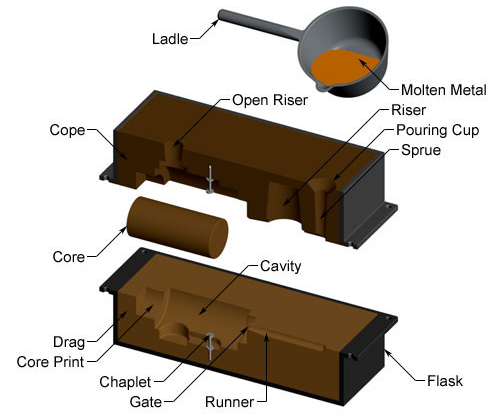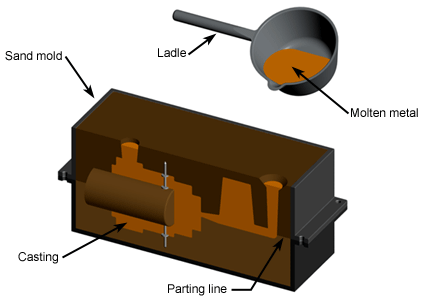CMS is a professional sand casting supplier in China. We offer a reliable and low cost sand casting solution, such as: green sand casting, resin bonded sand casting, shell mold casting and lost foam casting.
The main sand casting material has iron (grey Iron, ductile Iron, S.G. Iron), brass, aluminum, steel and etc.
We support technical standards of metal casting, includes: ASTM, ANSI, SAE, DIN, and BS.
Sand casting also called sand mold casting, it's used to produce a wide variety of metal components with complex geometries. These metal parts can vary greatly in size and weight, ranging from a couple ounces to several tons. The small sand cast parts include as gears, pulleys, crankshafts, connecting rods, and propellers. The larger sand casting applications include large equipment housings or heavy machine bases. Sand casting is also common in producing automobile parts, such as engine blocks, engine manifolds, cylinder heads, and transmission cases.
Process Cycle
The process cycle for sand casting consists of six main stages, which are explained below. 1.Mold-making - The first step in the sand casting process is to create the mold for the casting. In an expendable mold process, this step must be performed for each casting. A sand mold is formed by packing sand into each half of the mold. The sand is packed around the pattern, which is a replica of the external shape of the casting. When the pattern is removed, the cavity that will form the casting remains. Any internal features of the casting that cannot be formed by the pattern are formed by separate cores which are made of sand prior to the formation of the mold. Further details on mold-making will be described in the next section. The mold-making time includes positioning the pattern, packing the sand, and removing the pattern. The mold-making time is affected by the size of the part, the number of cores, and the type of sand mold. If the mold type requires heating or baking time, the mold-making time is substantially increased. Also, lubrication is often applied to the surfaces of the mold cavity in order to facilitate removal of the casting. The use of a lubricant also improves the flow the metal and can improve the surface finish of the casting. The lubricant that is used is chosen based upon the sand and molten metal temperature.
1.Mold-making - The first step in the sand casting process is to create the mold for the casting. In an expendable mold process, this step must be performed for each casting. A sand mold is formed by packing sand into each half of the mold. The sand is packed around the pattern, which is a replica of the external shape of the casting. When the pattern is removed, the cavity that will form the casting remains. Any internal features of the casting that cannot be formed by the pattern are formed by separate cores which are made of sand prior to the formation of the mold. Further details on mold-making will be described in the next section. The mold-making time includes positioning the pattern, packing the sand, and removing the pattern. The mold-making time is affected by the size of the part, the number of cores, and the type of sand mold. If the mold type requires heating or baking time, the mold-making time is substantially increased. Also, lubrication is often applied to the surfaces of the mold cavity in order to facilitate removal of the casting. The use of a lubricant also improves the flow the metal and can improve the surface finish of the casting. The lubricant that is used is chosen based upon the sand and molten metal temperature.
2.Clamping - Once the mold has been made, it must be prepared for the molten metal to be poured. The surface of the mold cavity is first lubricated to facilitate the removal of the casting. Then, the cores are positioned and the mold halves are closed and securely clamped together. It is essential that the mold halves remain securely closed to prevent the loss of any material.
3.Pouring - The molten metal is maintained at a set temperature in a furnace. After the mold has been clamped, the molten metal can be ladled from its holding container in the furnace and poured into the mold. The pouring can be performed manually or by an automated machine. Enough molten metal must be poured to fill the entire cavity and all channels in the mold. The filling time is very short in order to prevent early solidification of any one part of the metal.
4.Cooling - The molten metal that is poured into the mold will begin to cool and solidify once it enters the cavity. When the entire cavity is filled and the m olten metal solidifies, the final shape of the casting is formed. The mold can not be opened until the cooling time has elapsed. The desired cooling time can be estimated based upon the wall thickness of the casting and the temperature of the metal. Most of the possible defects that can occur are a result of the solidification process. If some of the molten metal cools too quickly, the part may exhibit shrinkage, cracks, or incomplete sections. Preventative measures can be taken in designing both the part and the mold and will be explored in later sections.
olten metal solidifies, the final shape of the casting is formed. The mold can not be opened until the cooling time has elapsed. The desired cooling time can be estimated based upon the wall thickness of the casting and the temperature of the metal. Most of the possible defects that can occur are a result of the solidification process. If some of the molten metal cools too quickly, the part may exhibit shrinkage, cracks, or incomplete sections. Preventative measures can be taken in designing both the part and the mold and will be explored in later sections.
5.Removal - After the predetermined solidification time has passed, the sand mold can simply be broken, and the casting removed. This step, sometimes called shakeout, is typically performed by a vibrating machine that shakes the sand and casting out of the flask. Once removed, the casting will likely have some sand and oxide layers adhered to the surface. Shot blasting is sometimes used to remove any remaining sand, especially from internal surfaces, and reduce the surface roughness.
6.Trimming - During cooling, the material from the channels in the mold solidifies attached to the part. This excess material must be trimmed from the casting either manually via cutting or sawing, or using a trimming press. The time required to trim the excess material can be estimated from the size of the casting's envelope. A larger casting will require a longer trimming time. The scrap material that results from this trimming is either discarded or reused in the sand casting process. However, the scrap material may need to be reconditioned to the proper chemical composition before it can be combined with non-recycled metal and reused.
Suitable material: Ductile Iron (SG Iron/Spheroidal Graphite Iron), Grey Iron, Cast Steel, Aluminum, Brass:

We provides a high quality affordable solution for metal casted products according to customer requirements. We are able to utilize our low cost structures in China, and provide a low cost and reliable final product, lower than almost any other countries sand casting manufacturer.

Green Sand CastingGreen Sand CastingGreen Sand CastingGreen Sand Casting
Green sand casting is the most widely and most convenient method of sand casting. It has the advantages of low cost, flexibility, high productivity, short production cycle and etc. With approximately 60 - 70% usage of all sand casting. Green sand casting is cheaper than resin bonded sand casting.

The resin bonded sand as a barrier in the casting production. It can effectively prevent the sand sticking on the cast parts. And it can removed nitrogen, sulfur and other gases. So it can guarantee the quality and stability of cast parts.

Shell mold casting process offers better surface finish, better dimensional tolerances, and higher throughput due to reduced cycle times. The materials that can be used with this process are cast iron, grey iron, ductile iron, carbon steel, stainless steel, alloy steel, aluminum, aluminum alloy etc. We provide OEM services and have a team of experienced engineers.

Advantages of Sand casting (Sand Mold Casting):
1. Can produce very large metal parts
2. Can form complex shapes
3. Many material options
4. Low tooling and equipment cost
5. Short delivery times

